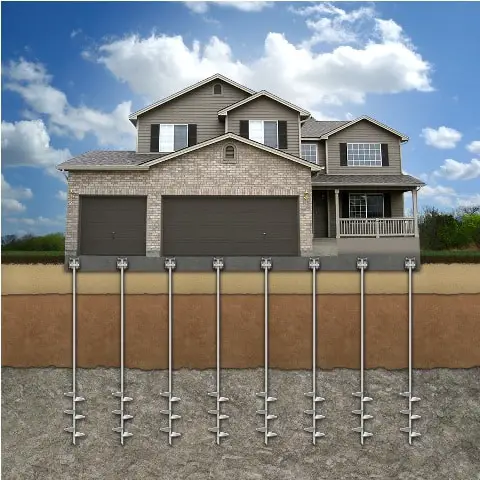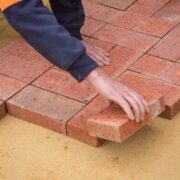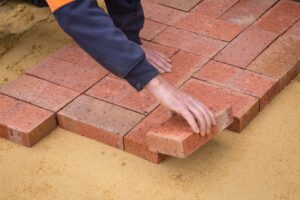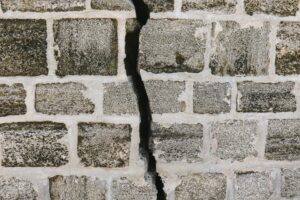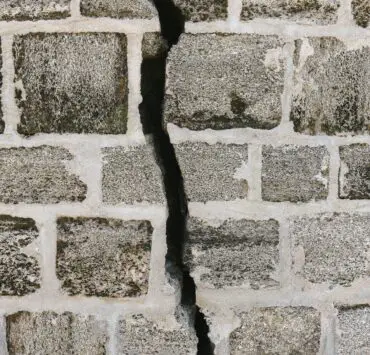What are Helical Piers?
Helical piers serve as foundation support systems comprising steel shafts with spiral-shaped blades.
Employing hydraulic equipment, these piers are inserted into the ground and can provide support for both newly constructed and existing buildings.
They are particularly useful in cases where the soil lacks the strength or stability required for conventional foundation techniques like driven piles or drilled shafts.
Helical piers are also preferred in areas with restricted space for machinery, making them well-suited for compact urban locations.

How are Helical Piers Installed?
The installation of helical piers is tailored to the specific application.
When placing them beneath an existing structure, the process involves excavating the designated area. Subsequently, hydraulic methods are employed to drive the helical piers into the ground, with a pressure gauge guiding the depth of penetration.
The required number of piers for a project varies, and they can be cut to the appropriate lengths. Attaching the piers to the structure is facilitated through brackets, with some necessitating interior installation.
Once the piers are securely in place, the jacking process commences. Upon achieving the desired height for the structure, the installation crew completes the restoration of the site.
How Much Do Helical Piers Cost?
Opting for helical piers for foundation repair offers greater versatility compared to alternative support choices.
The cost of helical piers can range from $1,750 to $3,000 per installed pier. On average, the installation expense hovers around $2,375 per pier. Expenses can vary depending on additional requirements, such as concrete.
As previously noted, the cost of piers can range from $15 to $30 per foot, with the overall cost influenced by the length and size of the piers.
Factors influencing installation costs include the quantity of piers needed and the condition of the soil. Piers equipped with brackets will raise the cost, whereas those featuring beam caps may incur lower expenses.
Despite the variable costs, choosing helical piers can be a cost-effective solution, potentially saving you from the expense of a new concrete foundation.
| Average Cost of Helical Piers | |
|---|---|
| Average Cost | $2,375 |
| Highest Cost | $3,000 |
| Lowest Cost | $1,750 |
What is the Labor Cost for Helical Piers?
The labor cost for installing helical piers typically falls in the range of $1,000 to $1,500 per pier.
This cost is subject to variations depending on factors such as soil conditions, accessibility to the foundation, the weight of the structure, the size of the crew, and the quantity being installed.
Larger piles may necessitate more substantial equipment to generate the required torque for their installation.
Factors Affecting Cost of Helical Piers
Geographic Location
Geographic regions vary in frost depths and soil quality, influencing the needed pier depth. Softer or sandy soil may require deeper pier driving, incurring extra costs. High water tables or different altitudes pose additional considerations.
Soil Condition
Soil conditions, especially compaction, impact helical pier installation costs. Rocky soil presents challenges, potentially increasing expenses. Sandy or uniformly compacted soil facilitates easier and more economical installation.
Installation Depth
Soil composition and water table levels determine the required depth for helical piers. Consistent soil allows standard depths, reducing costs. Deeper depths, costing $25 to $35 per foot, may be necessary in certain areas.
Access and Excavation
Access to the foundation affects the cost, as some projects may require more work or interior pier installation. Excavation locations, involving dismantling outdoor features like decks or patios, also impact expenses.
Type of Project
Project type and structure size impact costs, with larger projects requiring more piers. Unique designs may necessitate unique solutions, influencing overall expenses. The design of the home can introduce special considerations.
Permits and Engineering
Securing permits and necessary engineering adds to the project cost, contributing to overall expenses.
Extent of Damage
The extent of damage influences repair costs. More extensive damage may require more piers for stabilization.
Number of Piers Needed
The number of piers affects the price, with each pier costing around $3,000 installed. The estimated quantity is included in the contractor’s quote, considering the depth needed.
Labor Costs
Labor costs for helical pier installation typically range from $1,000 to $1,500 per pier. This varies based on soil conditions, accessibility to the foundation, weight of the structure, crew size, and quantity being installed.
Landscaping
Landscaping near the foundation adds to the cost, requiring removal and replacement. Costs depend on the extent and salvageability of the vegetation, potentially amounting to thousands of dollars.
Helical Piers VS other Foundation Support Systems
| Helical Piers | Steel Piers | Concrete Piers | Straight Shaft End-Bearing Piers | |
|---|---|---|---|---|
| Average Installation Cost Per Pier | $2,375 | $1,500 | $1,000 | $2,000 |
| Average Total Installation Cost | $17,800 | $13,500 | $5,000 | $20,000 |
| Types of Soil to Install In | Sandy, dirt, clay | Rocky, clay | Most since concrete piers don’t need much depth | Unstable soil |
Helical Piers: Maintenance
Maintaining helical piers is a hassle-free task. Monitoring your foundation is crucial, and if you notice any settling or unevenness, prompt inspection is recommended. While repairing helical piers might involve excavation to address issues, their steel composition means they typically require minimal repairs.
Pros and Cons of Helical Piers
Pros
- Quick Installation: Helical piers can be drilled in as little as 10 minutes, offering a swift installation process.
- Long-lasting: With an estimated lifespan of up to 150 years, helical piers provide a durable foundation solution.
- Permanent Fix: Helical piers are considered a permanent fix, requiring minimal to no maintenance after installation.
- Versatility: Installers often prefer helical piers for their versatility, easy installation, and robust load capacity.
- Sagging Foundation Repair: Helical piers offer a reliable solution for repairing and supporting sagging foundations.
Cons
- Expensive: One notable drawback of helical piers is their higher cost compared to concrete and steel piers.
- Challenges in Rocky Soil: The screw-like design of helical piers can pose challenges in rocky soil, making installation less effective.
- Excavation Required: Similar to other foundation methods, helical piers necessitate some excavation during installation. This may involve the removal of structures like decks, patios, or landscaping, adding to the overall project complexity.
Frequently Asked Questions (FAQ’s)
Are helical piers superior to concrete?
Concrete piers are susceptible to frost heave and other weather-related problems. The water table penetration can also lead to issues for concrete. The installation of concrete piers generally requires more time compared to helical piers.
Despite the added cost, many consider helical piers a preferable choice over concrete piers. While concrete may offer a more suitable solution for smaller projects, such as decks or porches, helical piers excel in foundation repairs. Unlike concrete, helical piers are resistant to water damage and frost heave.
What is the weight of helical piers?
Helical piers are commonly available in 20-foot lengths and can weigh approximately 130 pounds. These piers typically boast a rated load capacity of 500 tons or more.
The length of piers can vary based on soil conditions, with contractors sizing them to meet the specific requirements of your structure. Piers may be available in shorter or longer lengths, tailored to the needs of the soil conditions and the depth to the frost line.
How many helical piers does a house require?
A typical home may require between five to 10 helical piers. The quantity of piers depends on the size and weight of the structure, with larger and heavier buildings often needing more piers for adequate support. The extent of damage also influences the number of piers contractors must install to address the issue.
Are helical piers a permanent solution?
Helical piers can serve as a permanent fix, boasting an estimated lifespan of around 150 years. Some helical piers even come with warranties, and many installers favor them for their ability to be installed in any weather. Additionally, helical piers work effectively in various soil types, setting them apart from other foundation support options.
